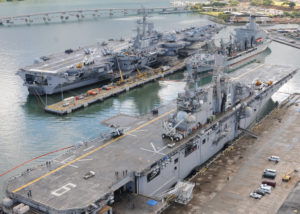
100706-N-6274T-091 PEARL HARBOR (July 6, 2010) The aircraft carrier USS Ronald Reagan (CVN 76), left, and the amphibious assault ship USS Bonhomme Richard (LHD 6) are moored in Pearl Harbor preparing for Rim of the Pacific (RIMPAC) 2010 exercises. (U.S. Navy photo by Mass Communication Specialist 2nd Class Corey Truax/Released)
At The American Conservative, Robert W. Merry examines the views expressed by two British publications, the FT and The Economist, that the growing competition between the United States and China is much broader than trade, and that the ultimate goal of the Chinese is to push America out of East Asia, all the way back to Hawaii. He writes (abridged):
From across the pond come two geopolitical analyses in two top-quality British publications that lay out in stark terms the looming struggle between the United States and China. It isn’t just a trade war, says The Economist in a major cover package. “Trade is not the half of it,” declares the magazine. “The United States and China are contesting every domain, from semiconductors to submarines and from blockbuster films to lunar exploration.” The days when the two superpowers sought a win-win world are gone.
For its own cover, The Financial Times’ Philip Stephens produced a piece entitled, “Trade is just an opening shot in a wider US-China conflict.” The subhead: “The current standoff is part of a struggle for global pre-eminence.” Writes Stephens: “The trade narrative is now being subsumed into a much more alarming one. Economics has merged with geopolitics.
China, you can hear on almost every corner in sight of the White House and Congress, is not just a dangerous economic competitor but a looming existential threat.”
Stephens quotes from the so-called National Defense Strategy, entitled “Sharpening the American Military’s Competitive Edge,” released last year by President Donald Trump’s Pentagon. In the South China Sea, for example, says the strategic paper, “China has mounted a rapid military modernization campaign designed to limit U.S. access to the region and provide China a freer hand there.”
The broader Chinese goal, warns the Pentagon, is “Indo-Pacific regional hegemony in the near-term and displacement of the United States to achieve global pre-eminence in the future.”
The Economist and Stephens are correct. The trade dispute is merely a small part of a much larger and even more intense geopolitical rivalry that could ignite what Stephens describes as “an altogether hotter war.”
As the Pentagon’s strategic paper posits, China’s overriding foreign policy goal is to squeeze America out of East Asia and force it back to the Hawaiian islands as its forward position in the Pacific. Thus would Hawaii cease to be America’s strategic platform for projecting power into Asia and become merely a defensive position. If this strategic retreat were to happen, it would be one of the most significant developments in international relations since the end of World War II.
Read more here.
If you’re willing to fight for Main Street America, click here to sign up for my free weekly email.




